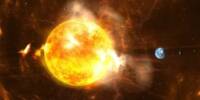When people are traveling, satellite navigation systems are essential for directing them on over-complicated routes. They assist vehicles in navigating even the most complicated routes by providing trustworthy directions. However, these technologies may leave users disoriented and possibly contribute to accidents in the unfortunate event of an unforeseen failure.
According to a recent study, satellite signals are disrupted when the underwater volcano Tonga erupts. These signals are essential for GPS tracking systems, which pinpoint the whereabouts of ships, planes, and cars with great accuracy.
The disruptive effects of an undersea volcano eruption on satellite signals across great distances have been the subject of an innovative investigation carried out by an international team.
The team’s results, published in the prominent journal Scientific Reports, show how a volcanically induced air pressure wave forms an equatorial plasma bubble (EPB) in the ionosphere, causing severe disruptions in satellite-based communications.

The ionosphere is a dynamic zone in the Earth’s upper atmosphere where solar energy ionizes molecules and atoms, resulting in the creation of positively charged ions. The F-region is a critical component of the ionosphere, spanning an altitude range of 150 to 800 km above the Earth’s surface. This region is crucial in long-distance radio communication because it reflects and refracts radio signals from satellites and GPS tracking devices back to Earth.
However, abnormalities might upset the delicate balance of the F-region. During the day, the ionosphere is ionized by the Sun’s UV radiation, resulting in an electron density gradient that is most concentrated near the equator.
Nonetheless, different disturbances such as plasma movement, electric fields, and neutral breezes can cause the creation of localized abnormalities with increased plasma density. These regions spread and change, resulting in the formation of bubble-like structures known as equatorial plasma bubbles (EPBs). The presence of EPBs can cause radio wave delays and affect GPS system performance.
Long thought to be influenced by airwaves, density gradients have been linked to terrestrial occurrences such as volcanic activity. An international team of researchers led by Designated Assistant Professor Atsuki Shinbori and Professor Yoshizumi Miyoshi from Nagoya University’s Institute for Space-Earth Environmental Research (ISEE), in collaboration with NICT, The University of Electro-Communications, Tohoku University, Kanazawa University, Kyoto University, and ISAS, took advantage of the historic submarine eruption in Tonga to investigate this theory.
The Tonga event, recognized as the greatest undersea volcanic eruption ever recorded, gave the scientists with a unique opportunity to test their idea. The researchers used modern methods to detect Equatorial Plasma Bubbles (EPBs) using the Arase satellite. Furthermore, the Himawari-8 satellite was used to follow the arrival of air pressure waves, while ground-based ionospheric measurements allowed for the tracking of ionosphere movements. They discovered an uneven structure of electron density throughout the equatorial region, which coincided with the arrival of pressure waves caused by the volcanic explosion.
“EPBs generated in Asia’s equatorial to low-latitude ionosphere in response to the arrival of pressure waves caused by undersea volcanic eruptions off Tonga,” Shinbori says.
In addition, the group uncovered something unexpected. For the first time, they demonstrated that ionospheric oscillations begin many minutes to several hours before the atmospheric pressure waves that cause plasma bubble formation. This has major implications since it means that the long-held concept of the geosphere-atmosphere-cosmosphere relationship, which states that ionospheric disruptions occur only after the eruption, must be changed.
The “new finding is that the ionospheric disturbances are observed several minutes to hours before the initial arrival of the shock waves triggered by the Tonga volcanic eruption,” Shinbori explains.
This study implies that the quick propagation of airwaves in the ionosphere causes these disturbances even before the shock waves get to their destination. As a result, it is critical to adapt the present model to include these fast atmospheric waves in the ionosphere.
“As a result, the model must be revised to account for these fast ionosphere atmospheric waves.”
Furthermore, they discovered that the EPB extended far beyond what traditional models predicted.
“Previous studies have shown that the formation of plasma bubbles at such high altitudes is a rare occurrence, making this a very unusual phenomenon,” Shinbori continues.
They “discovered that the EPB formed by this eruption reached space even beyond the ionosphere, implying that when extreme natural phenomena, such as the Tonga event, occur, we should pay attention to the connection between the ionosphere and the cosmosphere.”
The conclusions of this study have far-reaching ramifications not just in the arena of science, but also in the fields of space weather and catastrophe preparedness.
It has been found that in the event of a large incident, like the eruption of the Tonga volcano, an unanticipated break in the ionosphere can develop, even under circumstances that are normally regarded implausible under normal conditions.
Unfortunately, such possibilities have not been taken into consideration in space weather forecasting models. As a result, this research will help to prevent disruptions in satellite broadcasting and communication caused by ionospheric disturbances caused by earthquakes, volcanic eruptions, and other similar events.
















